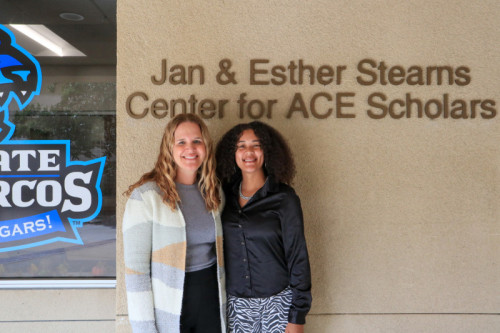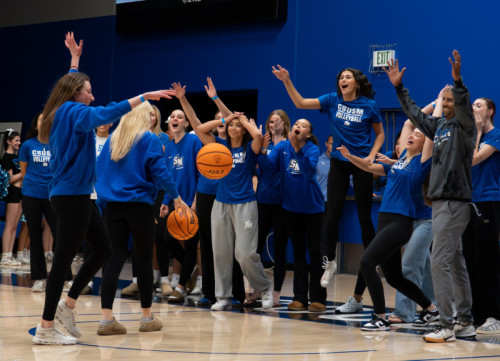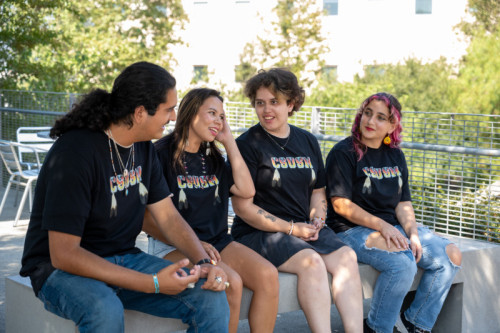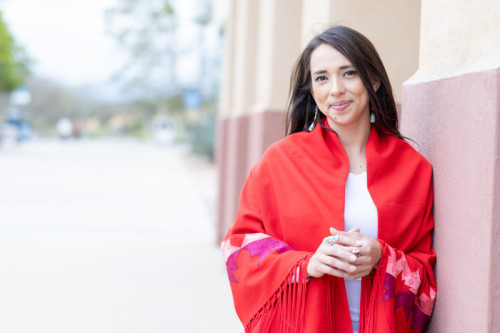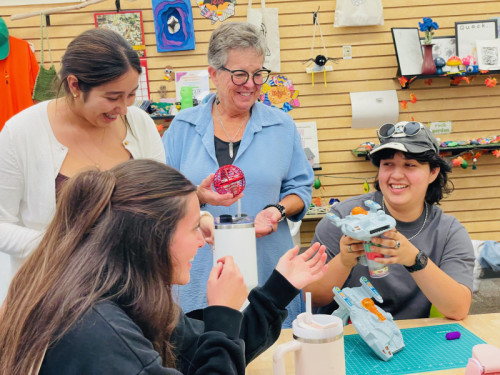Ask the Expert: A Scientific Perspective on the L.A. Fires
When the hills above Los Angeles exploded in flames early last month, Matt Rahn snapped into action.
Rahn, though, isn’t a firefighter who was called into duty to help battle what became one of the biggest and most destructive fires in California history. Rather, he’s a wildfire researcher at Cal State San Marcos who, in 2019, created a unique degree program called Wildfire Science and the Urban Interface. He’s also the executive director of the Wildfire Conservancy, a nonprofit research foundation dedicated to serving the state’s firefighters and protecting its communities.
The wildfires that devastated the L.A. area, and even caused minor damage in pockets of San Diego County, have been contained. But the significant problem of grappling with ever larger and more dangerous fires fueled by climate change is only growing worse, and Rahn can be found permanently stationed on the front lines of that fight.
Question: What was the nature of the work you were doing during the L.A. fires last month?
 Matt Rahn: I and my team at the Wildfire Conservancy have been doing research related to firefighter health and safety. Specifically, we have been conducting an exposure study related to the toxic, hazardous and carcinogenic materials firefighters are exposed to in a wildland urban interface fire. We are collecting data on exposures using silicon wrist bands (as a passive sampling device that is extremely good at absorbing all the contaminants firefighters are exposed to). We compare these to urine and blood samples taken from firefighters to track exposure to substances like polycyclic aromatic hydrocarbons (or PAHs), volatile organic compounds (or VOCs), heavy metals and other compounds. We use a variety of techniques, including micro RNA analysis that can measure the change in gene expression, particularly those responsible for either causing (or suppressing) cancer.
Matt Rahn: I and my team at the Wildfire Conservancy have been doing research related to firefighter health and safety. Specifically, we have been conducting an exposure study related to the toxic, hazardous and carcinogenic materials firefighters are exposed to in a wildland urban interface fire. We are collecting data on exposures using silicon wrist bands (as a passive sampling device that is extremely good at absorbing all the contaminants firefighters are exposed to). We compare these to urine and blood samples taken from firefighters to track exposure to substances like polycyclic aromatic hydrocarbons (or PAHs), volatile organic compounds (or VOCs), heavy metals and other compounds. We use a variety of techniques, including micro RNA analysis that can measure the change in gene expression, particularly those responsible for either causing (or suppressing) cancer.
Q: What was your reaction when you first heard about the fires? Could you have imagined that it would ever get that bad in the nation’s second-most-populous city?
MR: Sadly, I wasn’t shocked. For over 10 years now, we have been saying what is now common vernacular: We no longer have a “fire season,” we have a year-round fire risk. And we no longer have “wildfires” but rather fires in the wildland urban interface (or WUI), which is the area where human development and infrastructure meet undeveloped wildland or natural areas. But this change began much longer ago.
In 1991, in a remarkable and singularly cataclysmic event, the Oakland Hills became engulfed by a devastating fire that resulted in 3,280 homes lost, 25 fatalities and 1,520 acres burned. At that time, the loss was unthinkable; by today’s standards, the Oakland Hills fire, while still tragic, is certainly not the largest of its kind. That resulted in renewed recognition of the dangers posed by fires in the WUI and prompted new research and development into improved prevention and suppression methods, policy, and procedure of these kinds of fires. Unfortunately, that focus was short-lived, and over a decade would pass until California experienced another devastating wildfire, this time in San Diego County, that would grab national attention.
Engulfing more than 280,000 acres, destroying 3,241 homes and causing the loss of 16 lives, the 2003 Cedar fire surpassed all records and became the most devastating fire in California’s history. With a total economic loss of nearly $2.5 billion, we realized that the devastation was not contained to acres burned; the fiscal impacts to our communities far outweighed the actual cost of fighting this megafire. Even with a peak of 6,635 firefighters battling the blaze, suppression was less than 2% of the total cost of that wildfire incident.
For more context, since 1970, the U.S. has witnessed a roughly 300% increase in acres burned each year. Fifty years ago, wildfires would burn about 3 million acres per year across the entire U.S.; today, a single fire in California can consume one-third of that historic national acreage. So, fast forward to the fires in Paradise, California in 2018 and the 2023 fires in Maui, where over 100 people lost their lives. Sadly, we all should have seen this coming.
Q: Do you think there’s any merit to the criticism that city officials could have done more to keep the fires from getting so out of control? Or was this strictly a scenario of worst-case environmental conditions?
MR: Persistent drought, hot and dry temperatures, and extremely high winds in a community not built to modern standards for wildfire-prone areas were dangerous starting conditions for any fire event. The high winds provided an extremely short opportunity to prevent a conflagration. These winds also prevented the use of aerial attacks in the early stages of the fire. Fire agencies were left with ground resources, battling one of the most difficult and hazardous fire storms in U.S. history. Given the extreme fire behavior and conditions, the ultimate suppression and containment of the fires and prevention of additional losses was due in large part to the remarkable firefighter staffing and surge capacity that was mobilized.
It’s easy, if not dangerous, for folks so quickly to criticize agencies and municipalities, and make a tragic incident like this a political talking point. Organizations like Cal Fire, L.A. City and County Fire, and even the National Institute of Standards and Technology are all working to recreate the mobilization of resources and try to understand how response impacted outcomes. This is a very complicated and labor-intensive process that needs to be completed.
Q: If I’m remembering correctly, the worst fires in the state over the last decade or so have been in Northern California, including the Camp fire in 2018. Do you think Southern Californians had acquired a false sense of security and complacency?
MR: Unfortunately, many communities acquire a false sense of security and complacency. We see this year after year. When there is smoke in the air and a major incident that galvanizes our communities, state and nation, all the attention is given to that fire, with a collective promise that we will not forget and will work to keep our communities safe. But as time passes (and in some cases, not much time can pass), communities become lax in their collective efforts for fuel reduction programs, maintaining defensible space or other factors that can significantly contribute to community resilience. We cannot allow this to occur.
In fact, the Wildfire Conservancy along with some of our instructors in the Wildfire Science and the Urban Interface degree at CSUSM have teamed up to address this exact issue. We were awarded a grant from the FEMA Fire Prevention and Safety program in support of community resilience and advanced training support for Maui. Together with the County of Maui and Maui’s fire department, emergency operations and community associations, the Wildfire Conservancy will build on existing programs with the Responding to the Interface (RTI) program (from Cal Fire and the International Association of Fire Fighters) as the foundation for working with high-risk communities to develop a comprehensive and customized WUI firefighter training tailored to Maui and its communities, and create an annual event that is designed to improve community resilience, awareness, outreach and education. We are working to bring this effort to a national stage starting with Maui and continuing to California and beyond.
Q: What have you heard from the fire crews that were battling the blazes in L.A.?
MR: We have so far connected with hundreds of firefighters from Cal Fire, L.A. Fire Department, L.A. County Fire Department and other departments like Santa Barbara, Ventura, Fillmore, Oxnard and Pasadena. They are just now beginning to catch their collective breath and recover from these incidents. They are keenly aware of the exposures they have experienced in these fires. The success won by those “boots on the ground” may come at a significant personal and societal cost. The fires resulted in extreme high-level exposures for responding firefighters, at a scale not seen since Sept. 11, 2001. Many of us in the scientific community are speculating that these fires may well constitute an exposure incident that far exceeds that momentous day. The full impact has yet to be realized.
Q: How long have you been a scholar and researcher of wildfire science? How did you first get involved in it as a discipline?
MR: I began working on wildfire issues shortly after the Cedar fire in 2003 and became more fully engaged in research after the Witch and Guejito fires in 2007. My first projects were focused on things like fire sensors to provide early detection of wildfires in remote areas and economic impact studies related to the Cedar fire. I then moved quickly into research on attack effectiveness, completing the seminal study on wildland firefighter staffing that is still used to this day as the standard for helping advocate for proper state firefighter staffing. We then moved quickly into firefighter health and safety, given the impacts we were seeing related to cardiac events, dehydration and heat illness, and cancer. Since then, my time and effort on wildfire and urban interface fires has increased dramatically, culminating in the new degree program at CSUSM in 2019 and the launch the same year of the Wildfire Conservancy.
Q: How has the field evolved over the years as wildfires have gotten bigger and more destructive?
MR: We have been ringing the bell on wildfires and the WUI since the early 2000s. Back then, we were using terms like “the new normal.” Today, everyone is keenly aware of the risks, and the number of agencies, organizations and individuals involved in answering the call has increased significantly. Our first symposium on these issues was held a little over a decade ago in Sacramento, in partnership with Cal Fire and Cal Fire Local 2881. Experts from around California and the nation gathered and agreed that wildland firefighting was easily a decade behind structural/urban firefighting. The recommendation was to increase research and education programs in response to this. CSUSM has helped lead that effort with the new degree program, and organizations like the Wildfire Conservancy have formed to prioritize some of the most pressing issues facing our communities and first responders.
Q: How would you describe CSUSM’s wildfire science program and what it does?
MR: The degree program is unique. It’s focused on the WUI as its primary mission, educating our next generation of firefighters to deal with the unique issues related to these kinds of incidents. Clearly there is a need, and that need is growing. It is no longer just a California issue or something that is particular to the western U.S. Nearly every community in the nation has some kind of risk related to WUI fires. Providing the training and education for that growing risk is critically important.
What makes this program unique is that it was designed with firefighters and key agencies, including Cal Fire, the fire departments of San Diego and L.A., the U.S. Forest Service, NIST, and many other departments from around the country. We designed our curriculum based on their input, and it includes coursework in community planning and resilience, firefighter health and safety, wildfire law and economics, kinesiology and fitness, and even emerging tools and technologies. Our program also offers a course in firefighter mental and behavioral health, the first of its kind in the nation. The program is designed for working professionals, is fully online and has the ability to put a pause on coursework for students who may be deployed to major incidents during the semester. And yes, several of our own students were working on the L.A. fires.
We are lucky to have some of the foremost experts as instructors for some of the more specialized courses, and several remarkable faculty members at CSUSM also are teaching in this program. One last thing I should mention is that each student, at the end of their last semester, works with us to conduct their own “senior thesis” and research project focused on WUI issues. I’m happy to say that three of our former students will publish their research papers in the new Journal of the Wildfire Conservancy, a new science journal produced through the CSU system.
Q: CalMatters did an award-winning investigative series called “Trial by Fire” in 2022 about the traumatic toll of wildfires on firefighters, almost akin to being in war. How concerned are you about that, and what are some steps you’d recommend to deal with it?
MR: Modern firefighters are responding to some of the most horrific, toxic, hazardous and carcinogenic incidents ever imagined, working in environments where the human body was never meant to be. They are sleep-deprived and regularly experience potentially traumatic events that can affect their mental health. We are seeing the results of this today through rising rates of cancer (far higher than the general population), increased rates of suicide and suicidal ideations, and high rates of heart attack and stroke. We can and must do better for those who are sacrificing themselves (and their families) in service to our communities. This is why we started the degree program and launched the research foundation. I know this is the thing that motivates so many of our fantastic researchers, faculty, instructors and students who have dedicated their careers to helping.
Q: I know funding, and the lack thereof, is a big part of this, but how would you like to see firefighting improve to confront the threat posed by bigger wildfires fueled by climate change?
MR: We need to give our fire agencies the resources, staffing and technology they need to respond to these events. We absolutely do need more boots on the ground, air attack resources and access to new tools and technologies. We also need a significant investment in personal protective equipment and advanced technologies that can reduce occupational exposures and risk. Fire prevention is also a big piece of the puzzle. We need to take the commitment to fuel management and defensible space seriously, and dedicate the resources needed to create long-term, large-scale sustainable efforts. We also need to rethink our laws, codes and regulations related to housing, businesses and infrastructure, and invest in programs that can better inform future decision-making, land-use planning and community-wide wildfire protection plans.
Q: What lessons are you taking away from the L.A. fires? Should we be rebuilding in these fire-devastated areas? How can we make such communities more resilient?
MR: We as humans tend to build in high-risk areas, whether they are fire-prone or at risk from floods, earthquakes, tornadoes or hurricanes. We have made remarkable strides in addressing community resilience and facility-hardening across many of these high-risk areas, including wildfires. We know what can and does work, and considerable investments are being made to develop new materials, designs and strategies to increase protection. However, none of this works if we continue to allow for poor planning and fail to provide for programs to help improve and retrofit existing communities. It will continue to fail if we don’t take our commitment to fuel management and defensible space seriously. And it will fail if we don’t take immediate action finally to fund a full-time, year-round fire service through Cal Fire and provide our struggling fire agencies the staffing and resources they need to do their job. In addition, we desperately need a significant overhaul to California’s insurance laws and regulations. Each of these issues by itself is not a solution and can easily fail when handled alone. However, if we think of each issue as a separate stick, when they are bundled together, they form a stronger and more resilient unit. We are all in this together.
Media Contact
Brian Hiro, Communications Specialist
bhiro@csusm.edu | Office: 760-750-7306
Latest News Release
- Kinesiology Student's Inspiring Journey from Foster Care to GraduationSometimes even the smallest things can be taken for granted. Many students have never had to worry about affording a meal or squeezing in hours of sleep between their work and school schedules, but that’s not the case for Alexus Foster. Alexus was in and out of the foster care system from the time she was 2 years old. She has lived in countless different states and attended 17 different schools. However, with the help of Cal State San Marcos’ ACE Scholars Services program she is graduating this winter with a bachelor’s degree in kinesiology and a minor in dance. “ACE has had a really big impact on me,” said Alexus, “and for that I'm very grateful.” Alexus always knew she wanted to pursue higher education because she felt it would help her avoid the challenges her mother faced. Pregnant at 15 years old, Alexus’ mother struggled to raise a child. After her mom was kicked out of Alexus’ grandmother’s house, Alexus was sent to New York to live with her great grandfather. Her mother booked a return flight to California, and Alexus’s childhood was on a new course. Growing up, Alexus experienced the hardships of persistent custody battles and court-mandated counseling therapy. She was constantly moving among different households and family members. Alexus is 29 years old and the oldest of six siblings (the youngest being 15). Alexus was 16 when her siblings entered the foster care system for the first time. Alexus hoped to shield them from the reality that would be foster care. But Alexus and her siblings were apart for almost a year, which was one of the hardest times of her life. Alexus and her siblings have always had a strong bond, celebrating every holiday together at their grandparents’ house growing up. “I love my siblings, and I just want to be the best big sister they could have. If they ever need anything, they can call me,” Alexus said. As complicated as Alexus’ life was growing up, additional struggles began to arise as an adult. After moving out of her mom’s house at 19, trying to complete her degree while managing two jobs to afford her rent became a strenuous task. Alexus was attending Riverside Community College when she learned about ACE Scholars Services. It’s a program that would soon change Alexus’ life for the better. ACE Scholars Services helps former foster youth pursue higher education by providing services and support systems. ACE knows that helping foster youth earn a degree will provide them the tools and self-determination they need to succeed later in life. That’s been the case for Alexus. Alexus worked the overnight shift at the Ontario airport, ending her shift at 7 a.m., then driving from Rancho Cucamonga for her hour-plus commute to campus. When she hadn’t slept all night, ACE provided her a space to get rest during the day. When she didn’t have enough money to afford food or school supplies, ACE was there. When her car broke down, ACE was there. In October 2024, Alexus lost her job and was evicted, marking the start of a difficult time. However, ACE was once again there to help. “The support that I get from ACE, everything that I've been able to get through in my life is because ACE has always helped me, especially Leigh,” Alexus said. Leigh Quijada has been the director of ACE Scholars Services for the last two years after previously working with the program for 13 years as a counselor. She has played a huge role in Alexus’ life by not only guiding her but helping her get through every obstacle she has faced. “Persistence” and “resilience” were the two words Leigh used to describe Alexus. “I think Alexus might be the only student I’ve had who has been through it all and overcome everything," Leigh said. Leigh has been there for Alexus since the start of her journey at CSUSM and has watched her grow. When Alexus was put on academic probation last year because she had to prioritize going to work to pay her bills rather than attending class, Leigh did everything in her power and helped Alexus get re-enrolled. “She is probably one of the biggest people in my life,” Alexus said. “I wouldn’t be getting my bachelor's without Leigh; she’s definitely my rock.” After the difficult years Alexus endured as a foster child, she is graduating this winter and moving to Texas to begin her master’s studies in kinesiology. She has played sports since she was young and hopes to continue her love for that field as an athletic trainer for professional athletes. “People don't know what I've been through to get to this point,” Alexus said. “It's going to be a very big accomplishment.” Media Contact Eric Breier, Interim Assistant Director of Editorial and External Affairs ebreier@csusm.edu | Office: 760-750-7314
- Photo Highlights From Cougar MadnessCal State San Marcos students filled The Sports Center on Oct. 15 for Cougar Madness, the university's annual event celebrating the beginning of the college basketball season. The men's basketball team opens the regular season by hosting Concordia University on Nov. 14. The women's team also opens Nov. 14 with a home game against Azusa Pacific. Visit the athletics website for complete schedules for both teams. Relive some of the event highlights in the Cougar Madness photo slideshow. Media Contact Eric Breier, Interim Assistant Director of Editorial and External Affairs ebreier@csusm.edu | Office: 760-750-7314
- Seeking Healthy Adults to Participate in Exercise Training StudyHealthy adults ages 18 - 64 years old who exercise less than two days per week are needed to participate in an exercise training study conducted at CSUSM. Participants will complete 2 sessions per week of exercise for 12 weeks, during which time you must maintain your lifestyle. Upon completion of the study, you will be paid $250.00. Please email Dr. Todd A. Astorino, Dept. of Kinesiology, at astorino@csusm.edu for more information about the study.
- Celebrating Native American Heritage MonthThroughout November, Cal State San Marcos will be celebrating and recognizing the contributions of American Indians with a series of special events as part of Native American Heritage Month. CSUSM invites all members of the campus community to participate in the following events. Pow Wow Dance Workshops Tuesday, Nov. 4, 11, 18, 6-8 p.m., Serenity Circle Learn the history, meaning and movement of pow wow dancing in this interactive workshop led by Kiara Flores. Celebrate culture, community and tradition through dance. Chow on Deck: United in Service - A Celebration of Native American Veterans Tuesday, Nov. 4, noon, Epstein Family Veterans Center Deck American Indian Student Center NAHM Kick-Off Event Friday, Nov. 7, 5-8 p.m., USU Amphitheater CSUSM’s American Indian Student Center invites the campus community to celebrate the start of Native American Heritage Month. The evening will include traditional bird singing, pow wow dancing and storytelling along with food prepared by Chef Carmen of Island Smoke N’ Grill. CSUSM 2nd Annual Social Gathering Thursday, Nov. 20, 3-6:30 p.m., Mangrum Track & Field The event will feature traditional bird singers and dancers, along with local vendors showcasing Native art and jewelry. All are welcome to join in this celebration of community and culture. Media Contact Eric Breier, Interim Assistant Director of Editorial and External Affairs ebreier@csusm.edu | Office: 760-750-7314
- Alumna Finds Purpose in Advocacy for Native Children and FamiliesAs Maya Goodblanket reflects on her time as a student, she vividly remembers the day she found the California Indian Culture and Sovereignty Center at Cal State San Marcos. Goodblanket was nervous about checking out the CICSC. She didn’t know anyone on campus and was unsure about going inside. But she mustered the courage to open the door, and all of her anxiety disappeared as she was instantly welcomed. Little did she know that she was meeting mentors that day who would help her achieve the career she has today. Through intentional support from faculty and staff and inclusive spaces like the CICSC, CSUSM equips students to lead with identity, purpose and impact. “I was looking for that connection to my culture, and I found it on campus,” said Goodblanket, who received a bachelor’s degree in psychological science and a Master of Social Work at CSUSM. “I'm an out-of-state Native. My tribe is from Oklahoma, so I always am searching to reconnect with tribal communities and tribal culture.” Goodblanket, a member of the Cheyenne and Arapaho Tribes of Oklahoma, serves as an Indian Child Welfare Act (ICWA) court advocate for the Valley Center-based Indian Health Council, which provides health and wellness services for American Indian communities in north San Diego County. Any families involved in a child welfare case, such as a juvenile dependency proceeding, can rely on Goodblanket for support. "I work with moms and dads who are struggling with a variety of challenges," Goodblanket said. "One is substance abuse. My job is to support families in doing what they need to do to reunite with their kids if they’re not currently in a place to have them back. I also work with caregivers and family members who have taken placement of the children." Goodblanket’s cultural connection is at the heart of her advocacy. Under the ICWA, child welfare agencies must prioritize placing American Indian children with relatives or within their tribal communities whenever possible. “Natives are still removed at a disproportionate rate by child welfare services,” Goodblanket said. "When children are disconnected from their culture, their long-term outcomes aren't as strong as those who remain connected. That’s why the cultural component is such a vital part of the work I do." As a student, Goodblanket participated in CSUSM’s inaugural “Beyond the Stereotype" campaign to raise awareness about cultural appropriation and the harm caused by stereotypes. Goodblanket and other students were featured on posters across campus that challenged common misconceptions about underrepresented groups. She emphasized the need to raise awareness about issues like missing and murdered Indigenous women and the harmful sexualization of Native women through stereotypes and costumes, which contribute to broader societal perceptions and injustice. "Maya demonstrates how education driven by purpose and cultural knowledge creates lasting change,” said Joely Proudfit, chair of the American Indian studies department and director of the CICSC. “CSUSM remains grateful for her transformative impact, particularly through her leadership in the award-winning 'Beyond the Stereotype' campaign, where she challenged cultural appropriation with authenticity and understanding.” Goodblanket didn’t expect the campaign to have such a large impact, and its widespread presence across campus was surprising but meaningful. "I think it was really important to take that stance and just stand up,” she said. “And I think that's what college is all about.” Media Contact Eric Breier, Interim Assistant Director of Editorial and External Affairs ebreier@csusm.edu | Office: 760-750-7314
- Human Development Students Rediscover the Power of PlayWhen Cal State San Marcos human development instructor Kathy Fuller gathered her students for class recently, she didn’t hand out a lecture outline or cue up a PowerPoint. Instead, she invited them to The Makery, a hands-on, creative space in Kellogg Library, and gave them a simple instruction: play. She encouraged them to tinker, build, explore and let curiosity lead the way. It might have looked like fun and games from the outside, but for Fuller, the experience was a deliberate lesson in rediscovering something that many adults forget. “In our adult lives, we lose touch with play,” Fuller said. “But rediscovering it isn’t just about having fun – it’s a way to connect, build trust and spark creativity.” For Fuller’s human development students – most of whom are preparing for careers as counselors, educators or community advocates – the exercise carried a deeper meaning. Play, she explained, is a bridge to empathy and understanding, essential tools for working with people who are coping with stress, trauma or isolation. “Play builds trust, opens pathways for expression and helps people feel safe,” Fuller said. “It reminds us that learning and healing don’t always have to be serious. Sometimes they can be spontaneous.” Among those who found the experience unexpectedly refreshing was Daniel Lopez, a human development major and student ambassador for the College of Education, Health and Human Services. “Sometimes we get so focused on grades and deadlines that we forget how to just explore and enjoy the process,” Lopez said. “This experience reminded me that play isn’t just for kids – it’s a mindset that helps us stay creative, connect with others and bring joy into the work we’ll be doing in our future careers.” Fuller’s playful experiment also reflects the broader mission of CEHHS, which emphasizes holistic, human-centered approaches to learning and practice. In the end, the lesson was simple but profound: There’s room and real need for play in the serious work of helping others. Media Contact Brian Hiro, Communications Specialist bhiro@csusm.edu | Office: 760-750-7306








